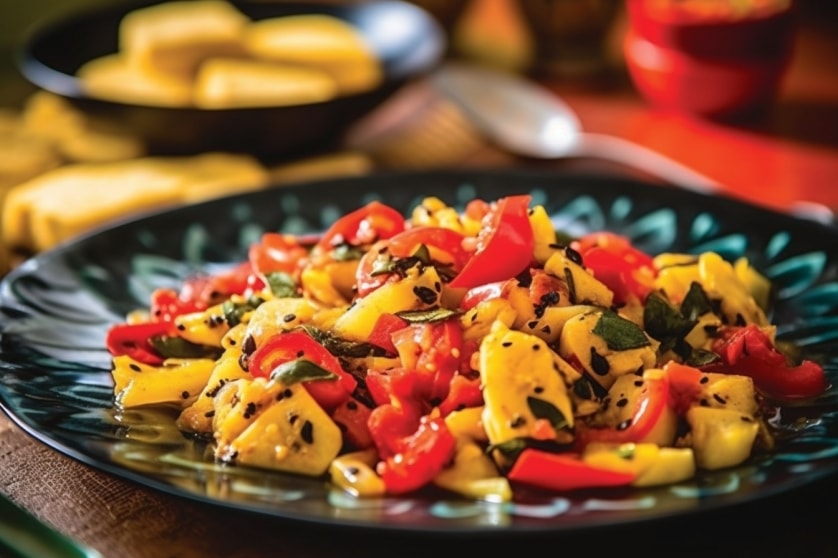Table of Contents
ToggleJamaican Ackee and Saltfish for Babies: A Traditional Breakfast Dish
Why Your Baby Deserves Better Than Bland
Here’s something most parenting books won’t tell you: your baby’s taste buds are incredibly sophisticated. While we’re spooning out another bowl of plain oatmeal, thinking we’re being “safe,” we’re actually missing a golden opportunity.
You see, research shows that babies who are exposed to diverse flavors early on don’t just become adventurous eaters—they become healthier, more curious individuals who embrace new experiences throughout their lives. And there’s no better way to start this journey than with Jamaican Ackee and Saltfish.
Now, I know what you’re thinking. “Saltfish for babies? Isn’t that too… intense?” But here’s the thing—when prepared correctly (and I’ll show you exactly how), this traditional Caribbean breakfast becomes a nutritional powerhouse that’s perfectly safe and incredibly beneficial for your little one.

The Incredible Journey of Jamaica’s National Dish
Every great dish has a story, and Ackee and Saltfish? Well, it’s got one of the most fascinating tales you’ll ever hear.
Picture this: It’s the 1700s, and a ship carrying precious cargo from West Africa docks in Jamaica. Among the treasures isn’t gold or silver, but something far more valuable—the Ackee fruit. This vibrant, mysterious fruit with its striking red exterior hiding golden flesh inside would soon become Jamaica’s national fruit.
But here’s where it gets interesting. Ackee isn’t just any fruit—it’s a fruit with secrets. When unripe, it contains toxins that make it dangerous to eat. But when perfectly ripe and properly prepared? It transforms into buttery, creamy perfection that melts in your mouth.
The saltfish part of our story comes from the practical wisdom of Caribbean fishermen who needed to preserve their catch before refrigeration existed. They discovered that salting codfish not only preserved it but created a flavor profile that paired magnificently with the delicate Ackee.

Mind-Blowing Facts That Will Change How You See This Dish
Ready for some facts that’ll make you the most interesting parent at the playground?
Fact #1: The Ackee Paradox – Ackee is both Jamaica’s national fruit AND part of its national dish, yet it’s not native to Jamaica. Talk about an immigrant success story!
Fact #2: The Safety Secret – That “dangerous” reputation of Ackee? It only applies to unripe fruit. Properly prepared canned Ackee (which is what we use for babies) is completely safe and has been enjoyed by millions for generations.
Fact #3: The Nutritional Goldmine – One serving of properly prepared Ackee and Saltfish provides protein, omega-3 fatty acids, vitamin C, vitamin A, and iron—basically everything your growing baby needs in one delicious package.
Fact #4: The Global Phenomenon – This humble breakfast dish has traveled from Jamaican kitchens to high-end restaurants in New York, London, and Toronto. Your baby will be eating like a sophisticated foodie!
Fact #5: The Texture Magic – The combination of creamy Ackee and flaky saltfish creates the perfect texture for babies transitioning to more complex foods.
The Baby-Safe Preparation Method (This Changes Everything)
Now, let’s address the elephant in the room. You might be wondering, “How do I make this traditional dish safe for my baby?” The answer lies in understanding a few key principles that transform this adult favorite into baby-friendly perfection.
The Desalting Game-Changer: The secret isn’t avoiding saltfish—it’s in the thorough desalting process. When done correctly, you remove virtually all the salt while retaining all the flavor and nutrients. It’s like having your cake and eating it too!
Timing is Everything: Introduce this dish around 8-10 months when your baby has already shown they can handle various textures and flavors. This isn’t a first food, but it’s an amazing second-stage adventure.
Texture Flexibility: The beautiful thing about this dish is its adaptability. For younger babies, you can create a smooth, creamy consistency. For older babies, you can leave some texture for them to explore.

The Incredible Benefits Your Baby Will Love
Let’s talk about why your baby’s developing brain and body will thank you for introducing Ackee and Saltfish:
Brain Development Boost: The omega-3 fatty acids in saltfish are like premium fuel for your baby’s rapidly developing brain. We’re talking about nutrients that support cognitive function, memory, and learning capacity.
Immune System Support: Ackee is packed with vitamin C—nature’s immune booster. Regular exposure to diverse, nutrient-rich foods like this helps build a strong immune foundation.
Protein Powerhouse: Growing babies need protein for muscle development, and this dish delivers it in a highly digestible, delicious form.
Iron for Energy: Both Ackee and saltfish provide iron, which is crucial for preventing anemia and supporting your baby’s energy levels.
Palate Development: This is the big one. Babies who experience diverse flavors early become more adventurous eaters throughout their lives. You’re literally programming their taste preferences!

Recipe: Jamaican Ackee and Saltfish for Babies (8-12 months)
Important Safety Notes
Please read before proceeding:
- Ackee Safety: Ackee fruit must be fully ripe before consumption. Unripe ackee contains toxins that can cause Jamaican vomiting sickness. ONLY use canned ackee for babies, as it’s guaranteed to be properly ripened and prepared.
- Saltfish Preparation: This recipe uses a very small amount of properly desalted saltfish to maintain authenticity while keeping sodium levels appropriate for babies. The thorough desalting process is CRITICAL for baby safety.
- Age Recommendation: This recipe is for babies 8+ months who are already consuming solid foods. Consult your pediatrician before introducing new foods, especially saltfish.
Ingredients
Makes 4-5 baby portions
Base Ingredients:
- 1 can (19 oz/540ml) ripe ackee, drained and rinsed thoroughly
- 1 oz (30g) saltfish/salt cod (will be thoroughly desalted)
- 1 tablespoon olive oil or coconut oil
- 2 tablespoons very finely diced onion
- 2 tablespoons very finely diced bell pepper (red is sweeter)
- 1 small tomato, seeds removed and finely diced
- 1 small sprig fresh thyme (leaves only) or a tiny pinch of dried thyme
- 1 small bay leaf (to be removed before serving)
Optional for 10+ months:
- Tiny pinch of black pepper
- 1 teaspoon finely chopped scallion (green parts only)
Equipment
- Small saucepan
- Nonstick frying pan
- Silicone spatula
- Fork for mashing (or food processor for younger babies)
Recipe Steps
- Thoroughly desalt the saltfish: This is the most critical step for baby safety!
- Soak the saltfish in cold water for 24 hours, changing the water at least 6-8 times.
- After soaking, place the saltfish in a pot with fresh cold water and bring to a gentle simmer for 10 minutes.
- Drain, and repeat the simmering process with fresh water for another 10 minutes.
- Taste a tiny piece – it should have almost no salt taste at all. If you detect saltiness, repeat the simmering process again.
- Once properly desalted, carefully remove all bones and skin, then flake the fish into very small pieces.
- Prepare the ackee: Drain the canned ackee and rinse gently under cool water to remove any brine. Set aside on paper towels to drain excess moisture. Handle carefully to maintain the delicate texture.
- Prepare the base: In a nonstick pan, warm the oil over low-medium heat. Add the finely diced onion and bell pepper, cooking until very soft (about 5-6 minutes). Add the thyme leaves and bay leaf, cooking for another minute until fragrant.
- Add tomato: Add the diced tomato and cook for 2-3 minutes until softened.
- Add fish: Gently mix in the flaked fresh fish pieces and allow to warm through for 1-2 minutes.
- Add ackee: Very gently fold in the ackee pieces with a silicone spatula, being careful not to break them up too much. Heat for just 2-3 minutes until warmed through. Remove from heat and discard the bay leaf.
- Cool and adjust texture: Allow the mixture to cool completely before serving.
- For 8-9 month babies: Mash gently with a fork to create a soft texture with small, manageable pieces.
- For younger babies who need smoother textures: Process briefly in a food processor with a splash of breast milk, formula, or water to achieve desired consistency.
- Storage: Refrigerate leftovers in an airtight container for up to 2 days, or freeze in baby-sized portions for up to 1 month.
Serving Suggestions
- Start with a small portion (1-2 teaspoons) when first introducing.
- Serve at room temperature or slightly warm (always test temperature before serving).
- This dish pairs well with:
- Mashed sweet potato
- Ripe mashed avocado
- Cooked and mashed plantain (for babies 9+ months)
Cultural Notes
This baby-friendly adaptation maintains the spirit of Jamaica’s national dish while making it safe for little ones. Traditionally, ackee and saltfish is served with hard food (boiled green bananas, yams, and dumplings), fried plantains, or festival (sweet fried dough). As your child grows, you can gradually introduce more authentic elements of this beloved Jamaican dish.
For a More Traditional Version (12+ months)
For toddlers over 12 months, you can make this dish slightly more traditional:
- Increase the amount of saltfish to 2 oz (still thoroughly desalted)
- Add a tiny pinch of scotch bonnet pepper (without seeds) for authentic Jamaican flavor
- Serve with small pieces of boiled green plantain or a tiny portion of boiled yam
As your child grows, they can gradually experience more authentic versions of Jamaica’s beloved national dish, including traditional accompaniments like festival (sweet fried cornmeal dough), fried plantains, or “hard food” (boiled green bananas, yams, and dumplings).
Your Baby’s Culinary Adventure Starts Now
You’ve just unlocked the secret to raising an adventurous eater who appreciates diverse flavors and cultural heritage. But this is just the beginning of your journey.
Remember, every spoonful of this traditional dish you offer your baby is a gift—not just of nutrition, but of culture, tradition, and love. You’re not just feeding them; you’re connecting them to a rich Caribbean heritage that spans generations.
Start small, be patient, and watch as your little one discovers the incredible world of flavors that awaits them. And most importantly, enjoy this special time together. These moments of exploration and discovery are precious—savor them!
Want to Take Your Knowledge to the Next Level?
Check out these must-read articles:
Organize your baby’s wardrobe with our baby clothes closet organizer products! Our organizers are designed specifically for baby clothes. Get your baby’s clothes neat and tidy with our selection of organizers – shop now!
- The Organic Baby Food Debate: What Actually Matters - July 2, 2025
- The Science of Baby Hunger Cues: Reading Your Child’s Signals - April 28, 2025
- Bottle Acceptance Strategies for Breastfed Babies - April 27, 2025



